12 Cranial Nerves Made Easy: Names, Functions & Nuclei Explained (With Diagram)
Nov 6, 2025
Navigate Quickly
Cranial Nerve
Inferior view of the brain and the base of the brain
Brainstem
Cranial nerves
Front view of the Brain stem
Brainstem and Cranial Nerve Nuclei
Clinical features of Lateral Medullary ischemia or Wallenberg Syndrome
Revision of Trigeminal nerve nuclei
Masseter Reflex (Jaw Jerk)
Trigeminal nerves
Nucleus Tractus Solitarius
Vagus Nerve
Frequently Asked Questions
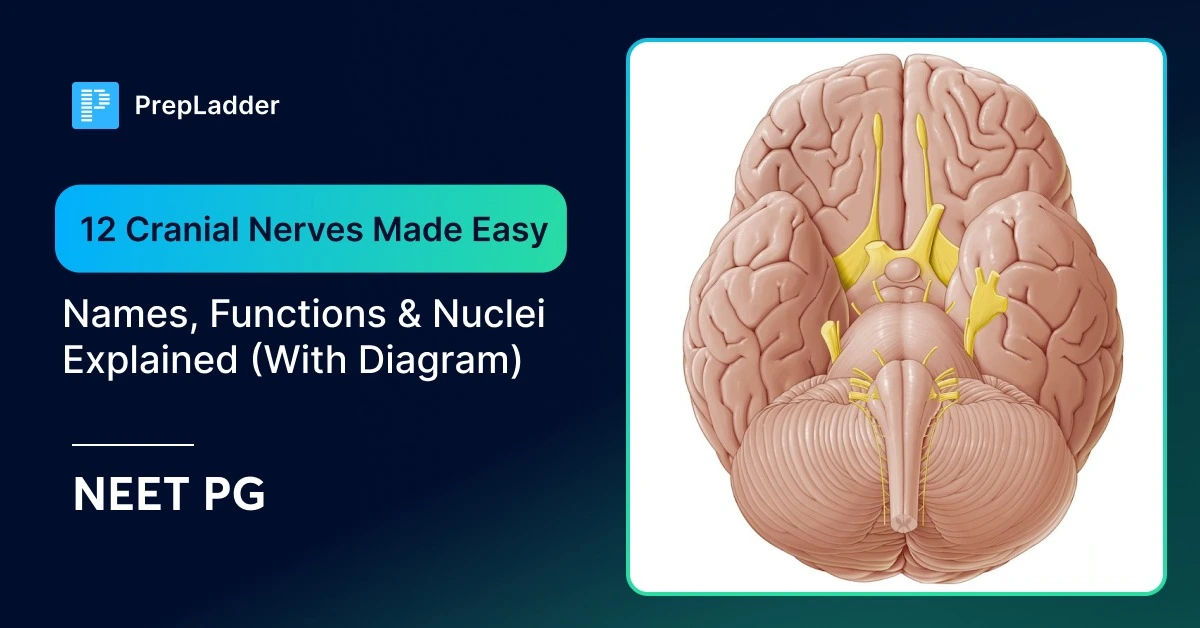
Cranial Nerve
There are 12 pairs of cranial nerves. Cranial nerves 1,2 come from the Forebrain. Cranial nerves 3 to 12 come from Brainstem. In the Brainstem, 3 components are present they are;
- Midbrain
- Pons
- Medulla oblongata
Inferior view of the brain and the base of the brain

- Cranial nerve no.1- Olfactory nerve
- Cranial nerve no.2- Optic nerve
- Cranial nerve no.3- Oculomotor nerve
Cranial nerve no.1 pathway, the olfactory nerve- Nerve of telencephalon. The optic nerve is the nerve of the diencephalon. Cranial nerve no. 3, the Oculomotor nerve, is present. The trochlear nerve is also present. The thickest cranial nerve is the trigeminal nerve, which comes from the pons. (Cranial nerve no.5). Cranial nerve no. 6 is the Abducens nerve. Cranial nerve no. 7 is the Facial nerve. Cranial nerve no. 8 is the Vestibulocochlear nerve
The 6th nerve is present at the midline, the 7th nerve is present laterally, and the 8th nerve is more lateral. These are all present at the ponto medullary junction as it is attached with pons and medullary region. The 5th nerve came from the pons. Whereas 3,4 comes from the midbrain.. 9,10,11 nerves from the medulla oblongata behind the olive. Nerve no.12 is present in front of the olive.
Brainstem
It has 3 components and gives cranial nerve no. 3 to 12
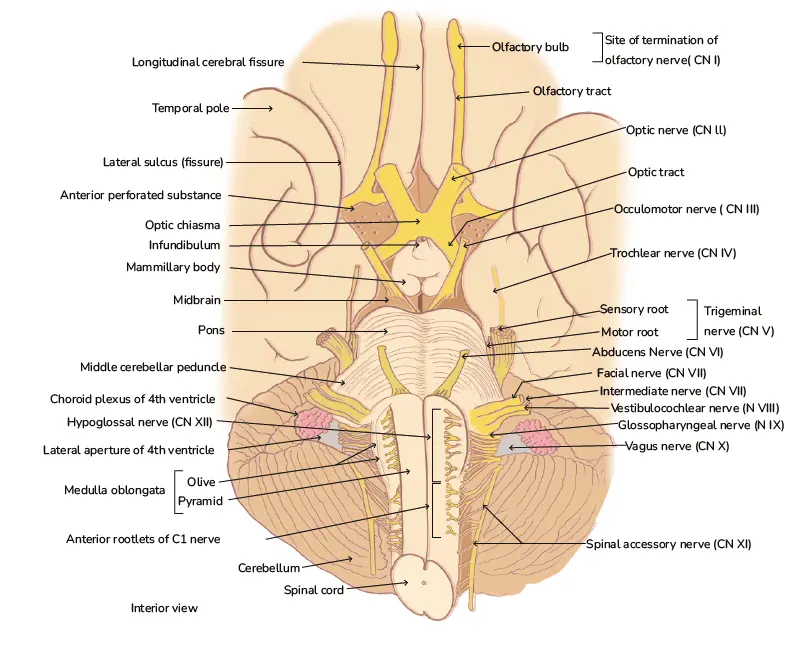
In the Brain stem, there is the crest cerebri of the midbrain, and below the pons is present, and then the medulla oblongata is present. The nerve no. 3 is coming from the midbrain and is present on both sides. The nerve no.4 is the thinnest cranial nerve as it has less no.of axons. It comes from the midbrain. The thickest nerve is the trigeminal nerve because it is 3 nerves into 1. Also has a lot of axons. Trigeminale, on the other side, comes from the pons.
The nerve no.6, Abducens nerve, is present near the midline at the pons medullary junction. The 7th nerve, the facial nerve, is lateral to that. The 8th nerve is lateral to the 7th nerve. The 8th nerve, Vestibulocochlear nerve, has two components. Nerves no. 9,10,11 are present behind the olives. Nerve no. 12 is present in front of the olives. In the Medulla oblongata, an anterior structure is present called the pyramid. The posterior structure is called an olive. Between the pyramid and the olive, the 12th nerve is present. Between the pyramid, which is anterior to the medulla oblongata and olive, which is posterior.
The 12th nerve is the sandwich between them. The pyramid is the most anterior structure in the medulla. After that nerve no.12, olive, nerves no. 9,10,11 are present orderly. From the spinal cord, the spinal accessory nerve comes. It is present at C1-C5. It will enter the foramen magnum and join the cranial part of the 11th nerve. The spinal accessory and the Cranial accessory run together. The cranial part of 11 comes from the Nucleus Ambiguous present at the medulla oblongata to control the muscles of the palate, pharynx, larynx, or for speech and swallowing. It comes behind olive.

Cranial nerves
No. 3,4 comes from the midbrain. No. 5 comes from the pons. The nerves no.6,7,8 come from the ponto medullary junction. The nerves no.9,10,11 come from the Nucleus Ambiguous behind the structure called the olive. The nerve no.12, the Hypoglossal nerve, is sandwich between the pyramid and the olive. The spinal accessory nerve comes from the spinal cord.
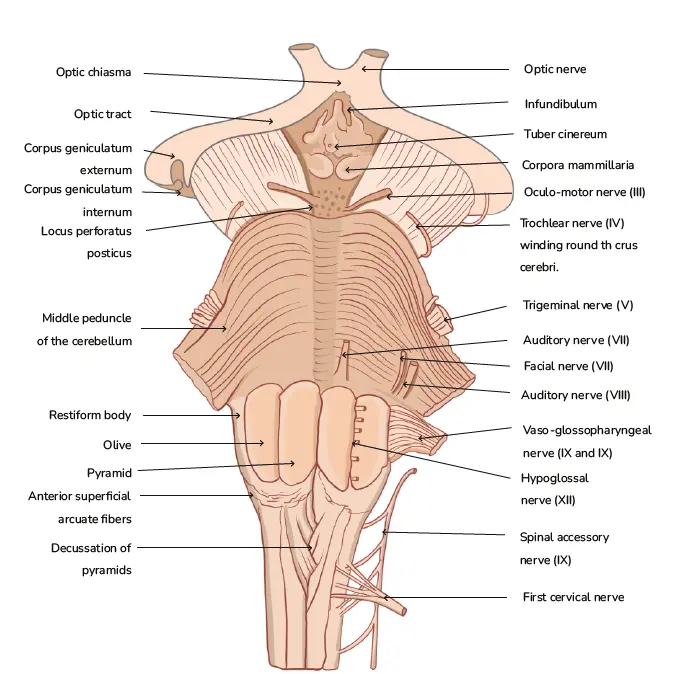
Front view of the Brain stem
The pyramid is the anterior one, olives are the posterior. They are present at the front side of the medulla oblongata.
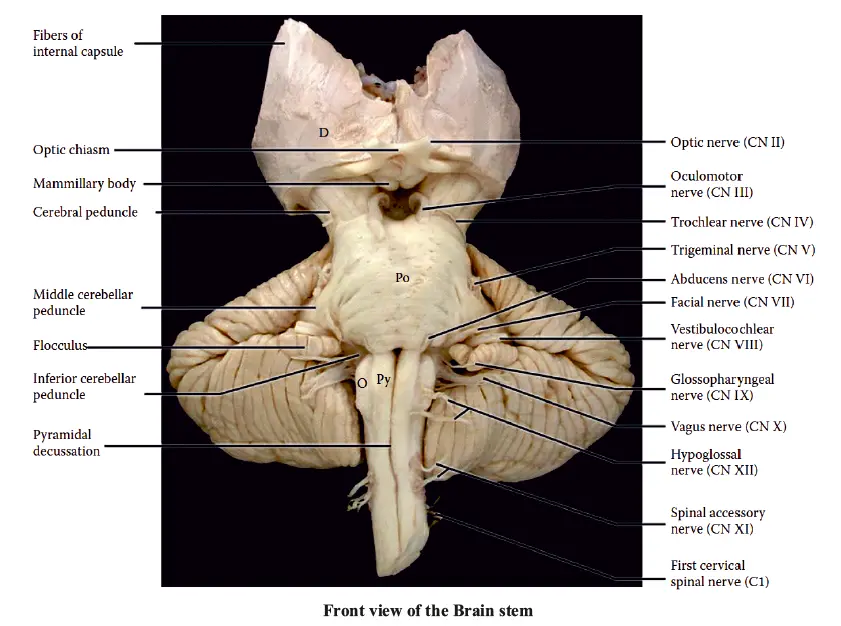
Brainstem and Cranial Nerve Nuclei

The midbrain, pons, and Medulla oblongata are the components of the Brainstem. 3-12 Cranial Nerve nuclei come under the Brainstem. Nerve nucleus no.3 is at the level of the superior colliculus, and 4 is at the level of the inferior colliculus. Nerve 5, 6, 7, 8 nuclei come from the pons but are not restricted to it. It may extend upwards or downwards into the midbrain and medulla. But chiefly they are present in the pons.
In the medulla oblongata,9, 10, 11, and 12 nerves are present. Nucleus ambiguus is the part of 9, 10, 11, especially the part of Cranial 11 coming from the medulla oblongata. Nerves 5, 6, 7 from the pons overlap with the neurons that go upwards or downwards. Trigeminal nerve nuclei are overlapping; there is one main sensory nucleus of it in the pons.
But there is a Mesencephalic nucleus of the trigeminal nerve going to the midbrain. The spinal sensory nucleus comes to the spinal cord. There is a main sensory area in the pons. From the nuclei in the medulla oblongata. Some of them are present near the midline, while the others are away from the midline. The nucleus ambiguus, the Spinal nucleus, and the Solitary nucleus are in the lateral medulla. But because of a compromise in the lateral medulla, with a syndrome called Wallenberg syndrome.
The nuclei involved in this are the Nucleus ambiguus, the Spinal nucleus of trigeminal, Solitary nucleus. The nucleus, which is present at the midline, is not involved in the syndrome. I.e, 12th nerve-Hypoglossal nucleus. The hypoglossal nucleus is involved in medial medullary syndrome, leading to tongue muscle paralysis. The midbrain, pons, and Medulla oblongata are the components of the Brainstem. The midline of the body is drawn. The brain components follow each other. The 3rd nerve nucleus gives the Oculomotor nerve. The 4th nerve nucleus gives the trochlear nerve. Nerve nucleus no.3 is at the level of the superior colliculus, and 4 is at the level of the inferior colliculus in the midbrain. Nerve 5,6,7,8 nuclei come from the pons but are not restricted to it. They overlap. Nerves 5,6,7 from the pons overlap with the neurons that go upwards or downwards into the midbrain or medulla oblongata. The nucleus of nerve no. 9,10,11,12 are present in the medulla oblongata. They’re not restricted.
The 8th nerve is at the pontomedullary junction. They’re not restricted to the pons and extend to the medulla. The vestibular area of the lateral medulla, a lesion giving vertigo, is the feature of Wallenberg syndrome. Lateral Medullary ischemia is seen, and it causes vertigo. Injury to the vestibular area is seen.
The trigeminal nerve has overlapping nuclei. It has one motor and three sensory nuclei. The motor nucleus of the trigeminal controls the mastication muscles, which develop in the 1st pharyngeal arch. It is present in the pons. The 3 sensory trigeminal have names like the main sensory, the mesencephalic sensor, and the spinal sensory nucleus. The spinal sensory nucleus is in the pons. The mesencephalic sensory nucleus of the trigeminal enters the midbrain.
The one that is going to enter the spinal cord passes through the lateral medulla, and it is called the spinal sensory nucleus of the trigeminal. It receives pain and temperature from the same side of the face to the same nucleus. It goes to the same side of the nucleus. It is considered Ipsilateral. It reaches the spinal sensory nucleus of the trigeminal. The mesencephalic sensory nucleus of the trigeminal is for receiving proprioception. Which means the position senses like the movement of the eyeball, tongue, and mandible. You can know the position sense by this nucleus.
Except for the pain, temperature, and proprioception, everything is done by the Main sensory nucleus. It gets activated through touch sensation, like touching the cornea. When you put the tuning fork to the Mastoid process, vibrations can also be received. Sensation can also be received.
Nerves no. 9, 10, and 11 make up the nucleus ambiguus and are seen in the lateral medulla oblongata. They control the pharyngeal arch muscles developing in the arch no. 3,4,5,6. They’re the muscles of the palate, pharynx, and larynx for speech and swallowing. Nucleus Tractus Solitarius, the tips will receive the sensation, and it is the lateral medulla. The FGV nerve will bring the taste to the tip of the Solitarius.
Mnemonic: SVA-T-NTS
SVA stands for special visceral sensation, the taste reaching the tip of the Nucleus Tractus Solitarius. Facial, Glossopharyngeal, and vagus nerves will bring the taste to the tip. It is in the lateral medulla. The 12th nucleus is near the midline and compromised is Medial medullary syndrome but not the lateral. These three nuclei and the vestibular will be compromised in the medial medullary syndrome.
Clinical features of Lateral Medullary ischemia or Wallenberg Syndrome
Vertigo due to injury of the Lateral medullary ischemia or the vestibular nucleus. Ipsilateral loss of pain and temperature on the face due to the injury of the Lateral medullary ischemia and the spinal nucleus of trigeminal. Loss of taste sensation from the same side of the tongue due to the Nucleus Tractus Solitarius. If you put the sensation on the same side of the tongue, you won’t feel the taste of the tongue. Difficulty in speech and swallowing due to paralysis of the palate, pharynx, and larynx muscles. It is due to the injury of the Nucleus Ambiguus. The 12th nucleus is affected in the Medial medullary syndrome.
Revision of Trigeminal nerve nuclei
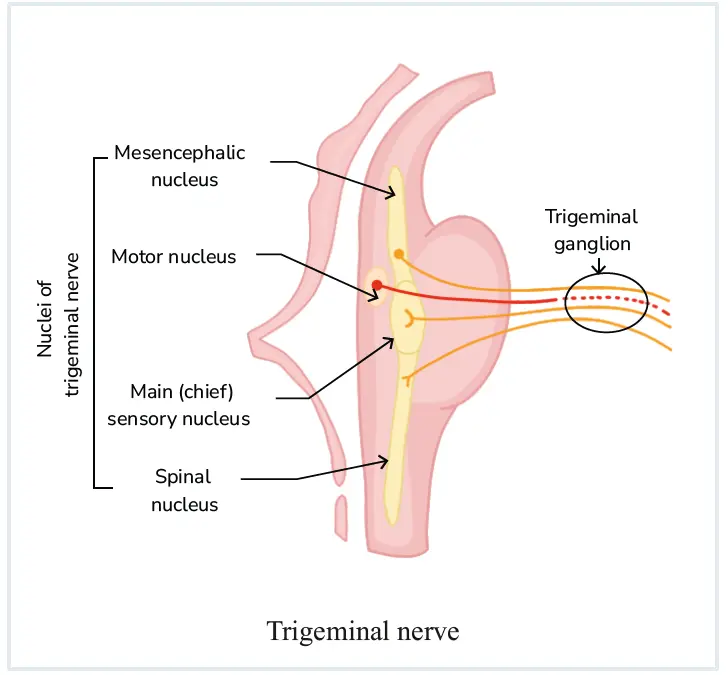
4 nuclei; 1- motor, 3-sensory
The motor nucleus controls the muscles of mastication in the first pharyngeal arch. 1 sensory nucleus goes into the midbrain called the Mesencephalic sensory nucleus of trigeminal to receive the position sense of the eyeball, tongue, or mandible. The spinal sensory nucleus of the trigeminal carries pain, temperature of the same side, touch sensation of the face or cornea, and tuning fork vibration sensation on the mastoid process to the main sensory nucleus.
Masseter Reflex (Jaw Jerk)
Take a knee hammer and hit the mentum by keeping a finger suddenly open in the mouth, it gets closed due to the reflex.

Trigeminal nerves
As the mandible changes position, it is proprioception. It is carried out by the mandibular nerve of the trigeminal. It is received by the Mesencephalic sensory nucleus of the trigeminal. It asks the motor nucleus to wake up and move the muscles on mastication. The motor nucleus of the trigeminal gets activated, and then the mastication nerves. It is the mandibular nerve of the trigeminal. It also carries motor fibres along with sensory fibres. The massator gets activated, elevates the mandible, and the mouth will close. You can’t control the reflexes. This is also called the jaw jerk reflex.
Nucleus Tractus Solitarius

Anterior 2/3rd of the tongue, the taste sensation is carried by the Chorda temporary nerve branch of the facial nerve towards the tip of the Nucleus Tractus Solitarius. The facial nerve is involved. Posterior 1/3rd of the tongue, then we have the Glossopharyngeal nerve. In the posterior tongue and epiglottis, the Vagus nerve carries taste sensation towards the tip of the Nucleus Tractus Solitarius
Vagus Nerve
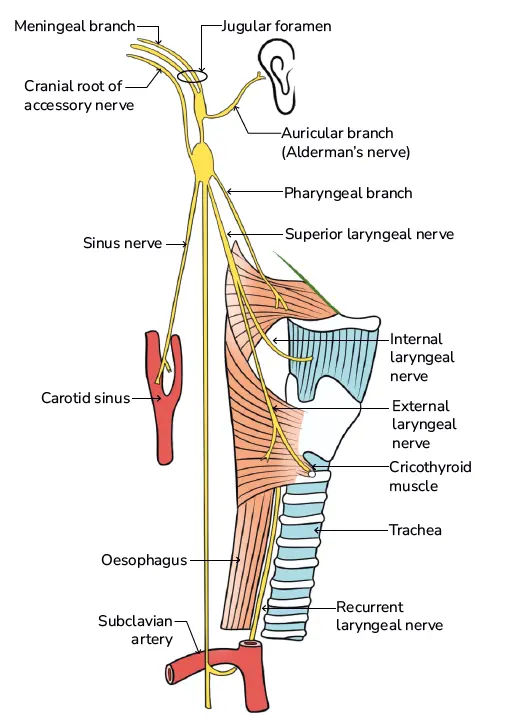
The vagus nerve is the longest cranial nerve. It is the 10th cranial nerve. The widest region of the body.
Supplies:
- Head and neck
- Larynx
- Thorax
- Abdomen
- Kidneys
- Upper ureter
Forms vagus accessory complex - Vagus nerve + cranial part of accessory nerve. Controls the muscles of:
- Pharynx
- Palate
- Larynx
Gives meningeal branch: To supply the dura mater in the floor of the posterior cranial fossa.
Auricular branch (Alderman nerves): Supplies the external ear. Passes through the vagus accessory complex.
Pharyngeal branches: Supplies pharynx, palate, and larynx. Also supplies the carotid sinus and constrictors of the larynx.
Frequently Asked Questions
Q1. Which cranial nerves originate from the Brainstem, and which CNs originate from the forebrain?
Ans.
- Cranial nerves 3 to 12 originate from the Brainstem
- Cranial nerves 1 (Olfactory nerve) and 2 (Optic nerve) come from the Forebrain
Q2. Special visceral sensation of taste is brought by which 3 CNs to the tip of the Nucleus Tractus Solitarius?
Ans: Facial nerve, Glossopharyngeal nerve, Vagus nerve
Q3. Mesencephalic sensory nucleus of the Trigeminal nerve (CN V) receives what specific sensory information?
Ans: Proprioception, including the movement of the eyeball, tongue, or mandible
Q4. In Wallenberg Syndrome, what causes difficulty in speech and swallowing?
Ans: Injury to the Nucleus Ambiguus, which controls the muscles of the palate, pharynx, and larynx
Q5. In Medial Medullary Syndrome, which nucleus is affected, and can it lead to?
Ans: Hypoglossal nucleus (CN XII), leading to tongue muscle paralysis.
Q6. Where is the location of the motor nucleus of the Trigeminal nerve, and what is its function?
Ans
- Location - pons
- Function - Controls the mastication muscles, which develop in the 1st pharyngeal arch
Q7. The main (chief) sensory nucleus of the Trigeminal receives 2 types of sensations.
Ans: Vibrations and Touch sensation
Q8. Which nuclei of the lateral medulla are compromised in Wallenberg syndrome?
Ans: Spinal nucleus of the trigeminal, Solitary nucleus, and Nucleus Ambiguus
Q9. Spinal sensory nucleus of the Trigeminal nerve (CN V) specifically receives what types of sensations from the face?
Ans: Temperature and pain from the same side of the face
Q10. What is the common reflex involving the Trigeminal nerve?
Ans: Masseter Reflex or Jaw Jerk Reflex
Download the PrepLadder app now and unlock a 24-hour FREE trial of premium high-yield content. Access Smarter Video Lectures also in हिंglish, Game Changing Qbank, Audio QBank, Structured Notes, Treasures, Mock test for FREE to ace your NEET PG preparation. Elevate your study experience and gear up for success. Start your journey with PrepLadder today!

PrepLadder
Access all the necessary resources you need to succeed in your competitive exam preparation. Stay informed with the latest news and updates on the upcoming exam, enhance your exam preparation, and transform your dreams into a reality!
Top searching words
The most popular search terms used by aspirants
- Anatomy Important Topics
- Cranial Nerves
- NEET PG Anatomy
- NEET PG Anatomy Preparation
PrepLadder Version X for NEET PG
Avail 24-Hr Free Trial
